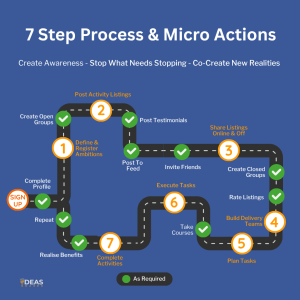Rethinking Procurement
Core Information
Ambition & Activity Detail
How AI Supports Procurement Function-Level Transformation
Introduction
Procurement is often hailed as the heart of enterprise value creation and risk management, yet remains one of the most under-leveraged domains when it comes to advanced AI implementation. While many organisations are exploring generative AI tools to enhance worker productivity (e.g., writing emails or slide decks), there is a distinct and transformative opportunity in using AI not for superficial gains, but to re-engineer the procurement function itself.
This article explores how AI can support true procurement function optimisation, the common pitfalls organisations face, and what foundational work must be in place to ensure success.
Section 1: Understanding Procurement’s Complexity
Procurement isn’t just about purchasing. It's an intricate matrix of planning, risk management, stakeholder alignment, compliance, supplier engagement, contract execution, and strategic sourcing.
Key Dimensions of Procurement:
>>> Strategic Sourcing
>>> Contract Lifecycle Management (CLM)
>>> Purchase-to-Pay (P2P)
>>> Supplier Performance & Risk Management
>>> Category Management
>>> Sustainability & ESG Compliance
Each of these components relies on:
>>> Clean, structured, and real-time data
>>> Workflow orchestration across tools and teams
>>> Institutional knowledge and context
Section 2: The True Role of AI in Procurement
AI can serve as a powerful engine to reconfigure how procurement operates, not just how individuals complete tasks. Key areas where AI can support functional transformation include:
2.1 Spend Analytics & Classification
>>> AI can normalise and classify large volumes of unstructured spend data
>>> Enhances visibility into rogue spend, supplier duplication, and savings opportunities
2.2 Contract Analytics & Clause Extraction
>>> Use NLP models to extract, classify, and compare clauses
>>> Enable risk scoring and renewal forecasting across hundreds of contracts in minutes
2.3 Supplier Risk & ESG Monitoring
>>> AI can monitor supplier news, litigation records, and ESG performance using external data streams
>>> Supports dynamic risk-based decision-making
2.4 Demand Forecasting & Scenario Modelling
>>> Machine learning can forecast demand based on seasonality, macroeconomic indicators, and historical usage
>>> Supports better planning and inventory alignment
2.5 Workflow Orchestration & Approval Routing
>>> AI can automate routing based on policy, hierarchy, and context
>>> Reduce delays, minimise manual errors, and improve compliance
2.6 Procurement Chatbots and Assistants
>>> Internal stakeholders can use AI-powered assistants for queries like:
>>>>>> “Where is my PO?”
>>>>>> “What are the top 3 suppliers for X category?”
>>>>>> “Generate an RFP draft for cloud hosting services.”
2.7 Compliance & Audit Readiness
>>> AI tools can flag non-compliance in real time
>>> Continuously monitor policy deviations, approval bypasses, and pricing anomalies
Section 3: The Pitfalls of AI in Procurement
Despite the potential, many AI implementations in procurement fail to deliver tangible outcomes. Common pitfalls include:
3.1 Poor Data Quality and Silos
>>> AI thrives on clean, labeled, and consistent data.
>>> Many procurement organisations have fragmented data across ERP, CLM, P2P, and Excel-based processes.
3.2 Misaligned Use Cases
>>> Deploying AI for generative tasks (e.g., ChatGPT writing an RFP email) instead of systemic challenges (e.g., automating sourcing workflows)
>>> Results in local, not transformational, benefits
3.3 Over-reliance on Generic Models
>>> Using out-of-the-box LLMs without fine-tuning leads to generic outputs that lack industry or category nuance
3.4 Lack of Process Ownership
>>> No clear process owner or functional sponsor
>>> AI is layered on top of broken or ambiguous processes
3.5 Ethical & Governance Risks
>>> Poorly trained AI models can reinforce bias in supplier scoring or risk models
>>> Lack of transparency in decision-making = audit risk
3.6 Change Management Deficits
>>> Procurement teams often lack training to understand or trust AI outputs
>>> Resistance grows when AI appears as a black box
Section 4: What Must Be in Place Before Implementing AI
Before implementing any AI initiative, procurement leaders must lay the groundwork. This involves:
4.1 Process Maturity Mapping
>>> Use frameworks like CIPS Procurement Maturity Model
>>> Identify gaps, duplications, and bottlenecks
>>> Prioritise areas where AI can augment, not replace, decision-making
4.2 Data Infrastructure & Governance
>>> Centralise spend, supplier, and contract data
>>> Standardise naming conventions, metadata fields, taxonomies
>>> Build APIs and data lakes for AI to interface with
4.3 Clear Business Cases and KPIs
>>> Define success metrics: cycle time reduction, savings uplift, risk visibility improvement
>>> Focus on value, not just novelty
4.4 Role Design & Human Oversight
>>> Design new roles: AI Orchestration Lead, Prompt Engineer, Procurement Data Steward
>>> Ensure all AI models have explainability and override mechanisms
4.5 Integration Strategy
>>> AI should connect with existing ERP, P2P, CLM systems via APIs
>>> Avoid siloed AI tools that operate outside the core procurement landscape
4.6 Education and Upskilling
>>> Train procurement teams on AI basics, data literacy, and prompt design
>>> Build a culture of experimentation and continuous improvement
Section 5: The Future of AI-Orchestrated Procurement
As we look to the future, procurement will shift from being a transactional function to a strategic AI-augmented command center.
What We’ll See:
>>> AI proactively recommending suppliers based on real-time geopolitical and ESG factors
>>> Procurement orchestrating end-to-end source-to-contract workflows with minimal manual intervention
>>> Autonomous agents negotiating, redlining, and scoring contracts within risk guardrails
>>> Procurement leaders becoming AI strategists, data custodians, and orchestration architects
Conclusion
AI has the potential to redefine procurement—not by replacing people, but by enhancing every aspect of the procurement value chain. However, it must be done right: grounded in data, designed around mature processes, and governed by ethical, explainable frameworks.
As procurement professionals, our task is clear: to stop treating AI as a worker productivity gimmick and start using it to orchestrate and elevate the entire procurement function.
The real value isn’t in saving minutes on PowerPoint. It’s in reimagining how procurement delivers intelligence, efficiency, and strategic value—at scale.
Supporting Information
Location & Impact Details
Links
Vote To Help Prioritise Activity Listing
You must be logged in to rate.
Contact Details
There are no reviews yet.



